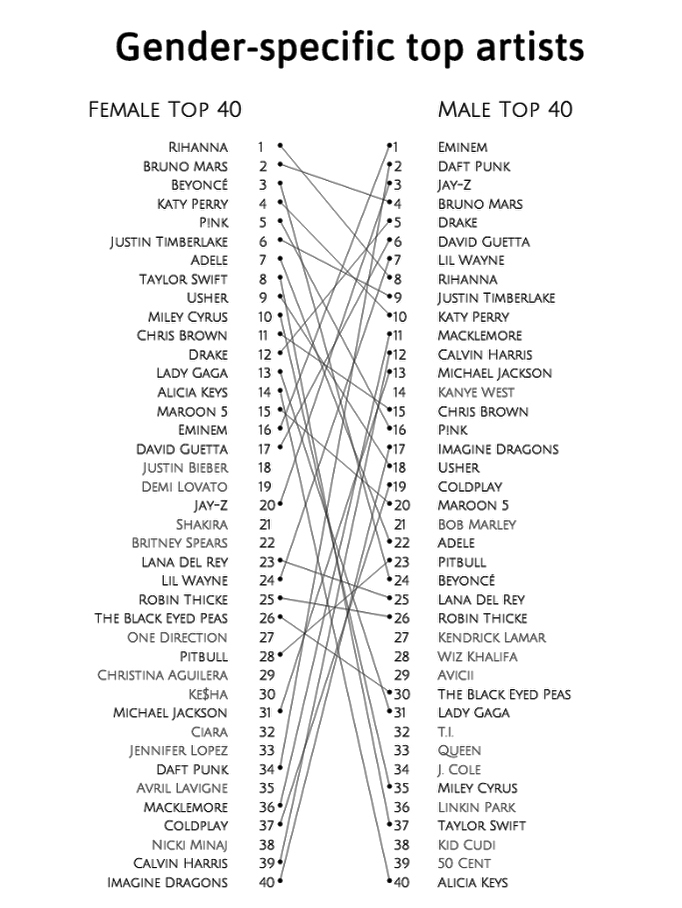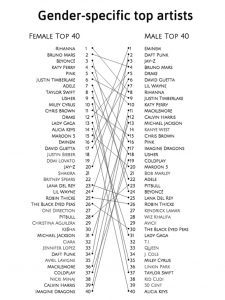
By Karlee Robinson

The Echo Nest, a music intelligence platform recently acquired by Spotify for $100 million, conducted a study in 2014 to see which artists men and women like, and how they differ. Analyzing the data of 200,000 listeners from various streaming platforms, the conclusions drawn illuminate the socially-constructed expectations of gender, how these expectations influence preference and, most significantly, how these social constructs pose limitations on the music industry and society’s understanding of diversity.
From the male and female Top 40 Lists, additional lists were composed of artists who made an appearance on one gender’s Top 40 List, and not on the other’s. The artists on these secondary lists consisted exclusively of those whose gender was identical to their listeners, except for Justin Bieber and One Direction. The two lists produced through the Echo Nest’s study exemplify the polarization of gender-related listening, as both female and male listeners were shown to favor artists of their own gender.
The young artists, Justin Bieber and the members of One Direction, differ from other male artists in both content and social image. Bieber, for instance, was only 19-20 years old during the time of this study. The average age of male artists on the Top 40 List and not on the female list is roughly 43 years old. Their age difference provides explanation behind their differences in content, but more importantly suggests two things: more important than gender’s role in shaping music preference, the ways in which this music preference is shaped by differences in content. These differences in content have been defined by the pressure artists face in conforming to gender-driven socially-constructed expectations.
The results of The Echo Nest’s study supports the position that listeners are encouraging conformity amongst the music industry. Listeners — those who musicians ironically serve and respond to — are standardizing the expression of an art that was founded on an ability to mobilize diversity in thought. Listeners have altered the music industry’s climate, so it now opposes the significance of musicians’ work.
Even more compelling is this study’s suggestion that male and female listeners have different expectations of the same male artists. The differences between socially-constructed expectations of gender are characterized by the relationship between the gender of the listeners and artists involved.
Music’s expression has never been limited to one category of subject matter. This allows musicians to reach diverse members of society. When listeners define their preference by what society has conditioned us to assume — in this case, specifically in regard to binary-driven gender identity — we’re limiting the inclusivity of their gifts. Not only are musicians pressed to compromise the completeness of their message, but their resulting shallow content perpetuates the regression of open perspective.
Seeing that male listeners generally prefer male artists, it’s time we uncover trends in content. The majority of artists on exlusively male listeners’ Top 40 List are pop artists. This doesn’t mean that women don’t also enjoy listening to pop music, but more specifically calls for comparison between the content of females’ and males’ favorite pop artists.
Artists Kanye West, Kid Cudi and 50 Cent (among other artists appearing only on the men’s Top 40 List) frequently include misogynistic language and other offensive content. This can be compared to artists One Direction, Demi Lovato and Britney Spears (among other artists exclusively from the women’s Top 40 List), whose content is diametrically rooted in feminist girl power and affirmation. The artists in this second group differ in gender, but are similar in their classification under a broader branch of pop music, meaning genre doesn’t define content. Difference in content is then left to be explained, at least in part, by gender.
As listeners, we have the power to define the success of artists in the music industry. With this responsibility, we need to not only encourage a broader representation of identity and expression, but also hold musicians accountable to the decency of their content. Seen recently in sexual harassment cases with celebrities Louis CK, Harvey Weinstein and Kevin Spacey, American pop-culture has a track record of allowing the success of celebrities who thrive on selfish feelings of entitlement. Content and character should be upheld above talent, but in the American landscape this rarely seems to hold true.
Because this study is dated, it would be interesting to conduct a more current study of identical intent, but this time, inclusive of non-binary identities (on the end of both listeners and artists). The data collected from this updated study would provide material for analyzing public response to more diverse artists. From here, we can attempt to understand why public response rewards or punishes diversity, and work toward advancing the music industry’s attitude toward a more thorough and forward-looking temperament.
If musicians feel pressured to limit the diversity of their expression, their listeners will be encouraged to believe that diversity is not only absent, but undesirable. Both suggestions are false. Understanding music to be artists’ personal expression, it’s fair to assume their lyrics reflect components of their identity. By broadening what’s included in popular music content, we can bring awareness to minoritized identities and encourage public acceptance.
